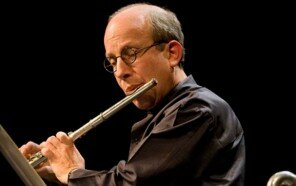Somewhere around the 1980s, when Baby Boomers began graying and the musical rebel cries of their youth settled into rose-tinted memory, the word psychedelic morphed from its original pharmaceutical context into quaint semaphore for anything with bright colors, or any band that exhibited even the faintest pinch of a ‘60s influence.
But psychedelic music’s about much more than meandering Granola blues riffs à la Canned Heat or The Grateful Dead, or a tie-dyed T-shirt. In the most ideal iteration of the term, psych-rock should be barrier-breaking, strange, exotic, outside-the-box, and informed by an altered state of being (and no, you don’t have to literally be on psychedelics to create or appreciate it).
Thank God there are a few bands out there looking to reclaim psychedelic music by doing their own thing. And this weekend, the Triple Door offers several hits of the best psych-rock out there with the Hypnotikon Seattle Psych Rock Fest.
Spurred by similar musical festivals in Austin and LA, Hypnotikon showcases nearly every bastard offspring of psychedelic music, from swoony shoegazer pop to the metronomic Cinemascope dissonance of krautrock. Both Friday and Saturday night feature local and national psych-rock acts, and at $25 per night (or $40 for both days), it’s a sensory feast at a reasonable price (check out the Triple Door website for all the deets). Here’s how the line-up for both nights stacks up.
Friday:
Fungal Abyss, Friday’s opening band, formed as a side project for Seattle prog-metal titans Lesbian, but FA’s grown into its own distinctive animal. Their long, often-improvised tracks unspool with a well-honed sense of sonic atmosphere and a backbeat that goes from jazzy to seismic in an instant.
Midday Veil, another Seattle-based project, provided Bumbershoot’s most headily-delicious hour this last Labor Day Weekend, and their Hypnotikon set will likely follow suit. Emily Pothast’s rich dark-chocolate chant of a voice gives the band’s wildly-experimental sonics (Indian Raga meets experimental electronic by way of Pink Floyd?) an exotic and mesmerizing center.
Bay area band Lumerians, by contrast, creates a dense, danceable drone that spikes traditional psychedelic rock tropes like trippy guitars and mind-expanding lyrics with stuttering percussion and fuzzed-out keyboards.
Chicago band Cave should make for a great capper to the evening: Sweaty rock energy runs roughshod alongside raga-like repetition, funk grooves, and caterwauling synths, and they’re reportedly as forceful as they are forward-thinking, live.
Saturday:
Seattle’s Jetman Jet Team open Day Two of Hypnotikon with a lovely, textbook example of psychedelia’s romantic kid sibling, shoegazer music. That translates to lush, tuneful, British-sounding pop songs wrapped in a blanket of symphonic guitar pings and whooshes. It’s a familiar formula that’s easy to take for granted, but Jetman do it to the swirly, fetching hilt.
Night Beats moved from Texas to Seattle a few years ago, chewing on the hallucinogenic roots of old-school psych-rock hellions like the 13th Floor Elevators the whole way. Like their psychedelic forebears, Night Beats play straight-ahead garage rock songs with the kind of ferocious live presentation that blows all notions of simple revivalism out of the water. If they’re not the most potently-rocking act all Hypnotikon, I’ll eat both of the hats I own.
Cloudland Canyon contrast Night Beats’ guitar-based sound with a heavily-synthesized style — monolithic, buzzing keyboards, walls of restless electronic percussion, and disembodied vocals that lend a trippy but distinctively human quality to the music.
It wouldn’t be a proper psych-rock fest, however, without at least one rediscovered act from psychedelia’s early days, and Hypnotikon closes out with a doozy.
New York duo Silver Apples began playing in the late 1960s, creating their own mini-universe of strange noises with vocalist/keyboardist Simeon’s handmade synthesizers and wraithlike voice, and Danny Taylor’s pulsing drums. The resulting sounds proved too damned weird even for the drug-fueled Sixties, but the metronomic drive and eccentricity of their catalog presaged current electronic dance music in a big way. Taylor passed away in 2005, so Simeon has carried on Silver Apples solo, partly utilizing the modern technology that his music helped shape in the first place. And hearing this 75-year-old guy creating alien sounds that still sound ahead of their time could turn out to be the most transcendent portion of the whole weekend.
